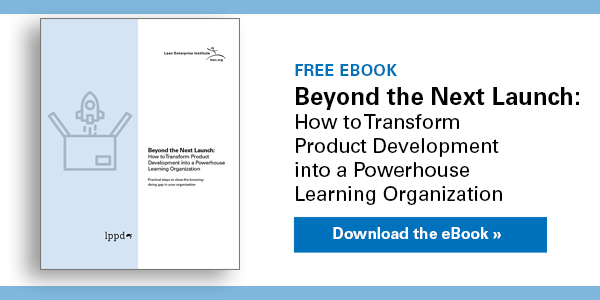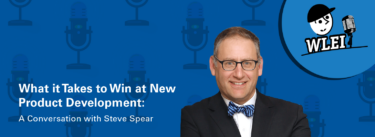Practical steps to close the knowing–doing gap in your organization
“A learning organization is an organization that is continually expanding its capacity to create its future.” I quite like this description of a learning organization from Peter Senge, author of The Fifth Discipline: The Art and Practice of the Learning Organization, recognized by Harvard Business Review as “one of the seminal management books of the last 75 years.” Simple and elegant, without trivializing. It captures both the importance and the difficulty of creating a real learning organization and emphasizes action.
Learning is creating. Learning is not superfluous; it is embedded in the organization’s DNA, and the organization is always working to get better at it. An organization like this is a juggernaut because a company’s know-how is its greatest competitive advantage. Learning organizations constantly hone their competitive edge to improve and move not only themselves but their entire industry forward.
Obstacles to learning organizations
So why don’t all organizations operate like this? Because it is hard! It’s far more difficult than most imagine at the beginning of the journey. Consequently, many organizations start down this path, but few become very good at it. It requires a level of focus, commitment, and grit not found very often. As Jeffery Pfeffer and Bob Sutton point out in their book The Knowing—Doing Gap, it’s just so much easier to talk about it than to do it.
Despite all their talk about continuous improvement, many organizations are basically complacent. There is no real passion for excellence.
Despite all their talk about continuous improvement, many organizations are basically complacent. There is no real passion for excellence. “We’re doing okay, making money, shipping (mostly) on time, and our quality is good.” As my colleague Eric Ethington likes to say, “‘We are no worse than anybody else in our industry’ is the oft-heard battle cry of the mediocre.” Once it takes hold, it is difficult to disrupt this pattern of behavior. Because it’s easy. Because it’s all good. At least until one of those juggernauts moves into your neighborhood and shakes things up.
Another obstacle is that learning requires experimentation, perhaps taking a risk and doing something different. Identifying a problem or opportunity, forming a hypothesis, proposing an action, and then taking a calculated risk and trying it, often in a pilot program. Simple, right? Well, perhaps not so much, especially in organizations where leaders only value delivering the next quarter, and risk is a potentially career-limiting four letter word.
Building a learning organization is also challenging because many organizations focus on explicit knowledge, which is easily codified and transferred, the real benefit comes from tacit knowledge or know-how, which requires strong ties, trust, and time to transfer. Think of a master craftsperson and an apprentice. Learning by doing requires a coach or mentor to provide real-time feedback. According to Ikujiro Nonaka and Hirotaka Takeuchi, this is the only type of knowledge that creates a competitive advantage, but who’s got time for that?
Building a learning organization is also challenging because while many organizations focus on explicit knowledge, which is easily codified and transferred, the real benefit comes from tacit knowledge or know-how, which requires strong ties, trust, and time to transfer. Think of a master craftsperson and an apprentice.
So often learning is treated as something separate and not part of our “real job.” In this case, there never seems to be “time” to participate in learning efforts. It’s just on to the next project. Learning becomes some sort of extracurricular activity that we squeeze in if there is time. Organizations that chase shiny objects, that never stick with anything long enough to know if it works, are especially vulnerable. Creating a learning organization requires time and effort, often more than most organizations are willing to invest.
Successful learning organizations
So, what are some countermeasures for these failure modes? What do successful learning organizations do? Research findings are reasonably consistent, at least in my reading, and they match my experience in industry. This is not intended to be an exhaustive list (see references at the end of this PDF.)
- Have a plan and be intentional. Don’t leave it to chance. But be sure to learn and adjust as you go. Master what Chris Argyris calls “double loop learning.”
- Build learning into the work, the very fabric of the organization. Work toward what can make your performance better every day.
- Learn by doing, by experimenting, and get real-time coaching feedback.
- Align your learning and improvement activities with organizational goals and objectives.
What specifically can we do in product and process development where learning is the lifeblood of our work? Here are just a few tools and practices …
- Do not delegate this responsibility to some central bureaucrat who is motivated to create his own cottage industry. No, this responsibility lies squarely on the shoulders of the leaders of the expert organizations – especially in design and engineering. Get some support if you need it, internally or externally. Nobody knows what’s needed better than you. Own it.
- Remember, creating a learning organization is a long-term commitment. This will not be easy or linear. But things of real value seldom are. Stick with it. Do not start if you are not prepared to commit to this.
Learning and knowledge re-use in product development
What specifically can we do in product and process development where learning is the lifeblood of our work? Here are just a few tools and practices that have been proven to be effective in product and process development. Some will be familiar, others may not.
- Start programs with a rigorous, decoupled study period that employs a set-based approach to learning and experimentation. New simulation technologies make a set-based approach even more powerful. This is your chance to deeply understand your customer, context, and true purpose of your new product or service. Create a learning plan, identify knowledge gaps, and experiment with multiple possible solutions. Aim to observe, learn, discuss at the place where the work is done, as a core team.
- Capture and share knowledge with simple tools like tradeoff curves, attribute matrices, concept papers, and Part Development Plans (PDPs).
- A tradeoff curve is a powerful way to turn data into reusable knowledge. They represent the underlying physics or chemistry of a design and its both relative and ultimate performance.
- Attribute matrices map desired attributes of a product to alternative method or means of creating. A concept paper is the output of a study period. It captures what you learned, what the product should be, and your high-level plan to deliver.
- PDPs are a tool that I first learned about at Mazda. They are focused on a type of part or subsystem and provide a stepwise plan for development, as well as a link to required best practices. They also show how an engineer’s component fits into the higher-level schedule as well as crucial “gives and gets” required.
- Establish an active mentoring practice that emphasizes learning by doing (AKA “freshman project”) and grow leaders who thoroughly understand the work and make it their job to grow the next generation. Intentionally teach scientific thinking, go to the source and experiment; do not assume young engineers already do this. After all, leaders get the culture they demonstrate and tolerate.
- Make “go and see” the expectation. Get out of the conference room and cubicles and go see. This especially includes design reviews. Yes, get out of the conference room and go where you can best see what is really happening! Visit the customer in the field, the test rig, the prototype shop, the tool shop, the production plant. At the very least, focus on actual CAD data or test results. Design reviews, one of the greatest opportunities for learning, are often squandered. Don’t allow your design reviews to become glorified dog and pony shows featuring a sanitized slide deck with a goal to get off stage. They are not only a chance to teach the immediate technical lesson at issue, but a chance to demonstrate how you expect the team to approach design and engineering.
Jump Start Your Organizational Learning Journey Today
At LEI we apply these same lessons on effective organizational learning in our work with our LPPD learning partner companies. We start by spending time upfront understanding the current state and aligning on objectives with our partners. Together, we create a plan that includes targeted experiments.
We provide you with experienced coaches to provide guidance and feedback. We regularly reflect with senior leaders on the plan and progress. Finally, we facilitate cross-learning of non-competing companies who are on a similar journey. We work with organizations across a wide range of industries including consumer electronics, energy technology, automotive, heavy equipment, and many more.
Interested in learning more? Contact Lara Anderson at landerson@lean.org.
Many may feel that organizational learning falls into the “nice-to-do” category. Let me assure you, it does not. You are either learning and improving or you are falling woefully behind, especially today. For some of you, these may be muscles you have not used for a while, and that makes it a bit painful in the beginning. That’s okay, just start somewhere. You will improve over time.
We started with a Peter Senge quote, so I’ll finish with another. “Through learning, we re-create ourselves. Through learning, we become able to do something we were never able to do.” What would you like to do? How hard are you willing to work? We hope to hear from you soon.
References:
- Common Knowledge (Dixon),
- The Fifth Discipline (Senge),
- The Knowledge Creating Company( Nonaka and Takeuchi),
- The Knowing – Doing Gap (Pfeffer and Sutton),
- Learning in Action (Reid),
- On Organizational Learning (Argyris),
- Thinking Fast and Slow (Kahneman),
- The Toyota Product Development System (Morgan and Liker),
- The Toyota Way (Liker),
- Working Together (Lewis).
Designing the Future
An Introduction to Lean Product and Process Development.







